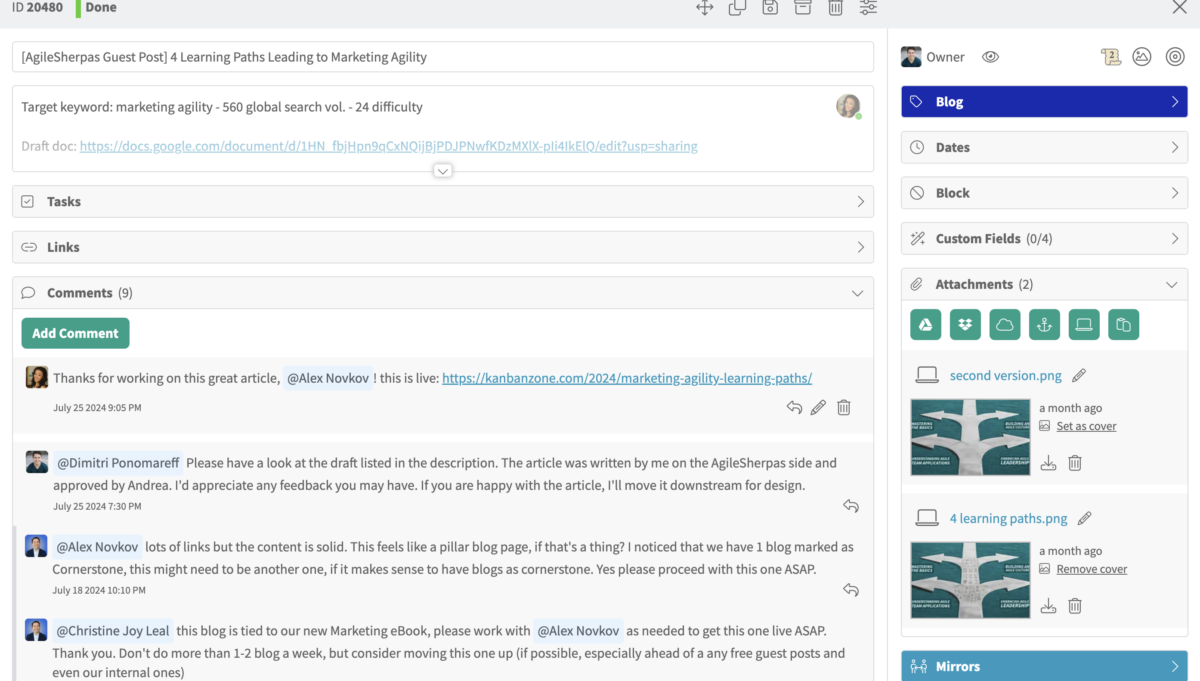
A good team that works well together has the right skills and is committed to the same goal can achieve great things. On the other hand, if your team is disjointed or there are notable skill gaps, it can feel like wading through thick mud trying to get the results you need.
Think of your project management team like an orchestra. To create a beautiful melody, you need the right people playing different instruments. Plus, they all need to play in tune and follow the same music score. How can you achieve this? Let’s find out.
Key Takeaways:
- The importance of a strong project management team. A project’s success depends on how well put together and effective its management team is.
- Orchestration of skills. Just like in an orchestra, a project team should have the right mix of skills and role functions to work in harmony toward a result.
- Strategic leadership. You must lead and nurture the project team to create a collaborative and supportive environment where everyone thrives and realizes their true potential.
Key Roles and Responsibilities in a Project Management Team
Let’s start by looking at the roles you can expect to include on your team.
Project Manager
The project manager is in charge of planning, implementing, and closing the project management plan. Think of them as the conductor of your orchestra, where the other project management team members are the musicians.
Project managers are in charge of the project’s timeline, and it’s their job to ensure important milestones are met, and the project is ultimately delivered on time. The project manager is also usually responsible for ensuring that the project runs within the constraints of the budget set by stakeholders and handling any risk management.
Project Sponsor
The project sponsor isn’t necessarily involved in the day-to-day running of the project – instead, their role is to act as a voice to the stakeholders. They are there to keep lines of communication open between the project team and upper management.
A project sponsor is usually an executive who ensures that the project gets high-level support and direction. They also help in making any major financial decisions and allocating funding that is needed for the project.
Team Members
Team members are all the people ‘on the ground’ who are responsible for carrying out the tasks that will lead to delivering the project.
Their roles and responsibilities will be different based on the scope and requirements of the project at hand, but ultimately it’s the project team members who will determine the success, or failure, of the project. If you want your project to go well, your team needs to be committed to its success, as well as having the right skills.
Business analyst
The business analyst acts as a bridge between the stakeholders and the project management team. However, they are typically much more involved in the daily running of the project (often via an analytics contact center) than a project sponsor.
Whereas a project sponsor tends to focus only on the project’s overall direction and outcomes, the business analyst is more involved in the details of the project and making sure it meets business needs.
Quality Assurance (QA) Manager
A QA manager is responsible for ensuring that the project’s final product conforms to the quality standards set.
The project manager and team members collaborate closely with the QA manager throughout the project’s life cycle to ensure quality standards are upheld. Their goal is to deliver a final product that meets or exceeds stakeholders’ expectations.
Resource Manager
The resource manager allocates all required resources, like manpower, machinery, or materials, that are needed to complete the project.
They will coordinate with the project manager to allocate and use these resources in the most effective and efficient way throughout the project.
Stakeholders
Stakeholders are any individuals or parties that have an interest in the project’s outcome. This might be clients, users, senior management, or other team members. They are usually not actively involved in the day-to-day running of the project but are required to provide information, feedback, and support for the life cycle of a project.
Subject Matter Experts (SMEs)
SMEs are people with specialized knowledge related to the project, such as IT wizards, legal pros, or finance analysts. They typically contribute to the project by offering their judgment and expertise when solving problems or making decisions.
Tips for Assembling the Right Project Management Team
Assembling a successful project team isn’t as simple as just putting people together in a room and hoping they get the job done. Here are some tips for making sure your team has the best chance of success.
Assess project needs and necessary skills
The sort of people and skills you’ll need will likely vary depending on the requirements and specific needs of the project at hand. So, before you assemble your team, you’ll need to look at the scope of the project, along with the objectives and deliverables, to determine who you need to be involved.
Look at any specific technical and non-technical skills that you’ll need to deliver your project and identify people who possess these skills that you can recruit for your team. This will ensure that your team is rich in the expertise needed to handle all areas of the project.
You should also consider different recruiting strategies, since most businesses focus on building inhouse teams and underestimate outsourcing. If you are looking for certain expertise in your team, it can be useful to find professionals through platforms such as Gigster or any of many Gigster alternatives.
Specify clear roles and responsibilities
Not having properly defined roles and responsibilities within your team can run the risk of important tasks being missed, with different team members all under the assumption that someone else was picking it up.
It’s important that everyone on your project management team knows exactly what they are required to do in terms of tasks, responsibilities, and expectations. Drafting detailed job descriptions for each role and using RACI charts can help team members understand how their contribution fits into the bigger picture of the project.
Balance experience with fresh perspectives
Of course, you need a certain level of skill and experience on your team, but don’t overlook the fresh perspectives that less-experienced team members could bring.
Ideally, aim for a balance of experienced members who can bring valuable insights and established methodologies alongside less experienced ones who can offer new ideas and innovative approaches.
When you have a good mix on your project team, it can encourage more creativity, and the team will be able to draw on a broad range of knowledge and skills.
Consider team compatibility and shared values
A fractious team will struggle to collaborate well, which can slow down progress and even jeopardize the successful delivery of the project.
When putting your team together, it’s not all just about technical and academic skillsets, you also need to pay attention to any potential personality clashes or differences in work style.
Try to put together a team that shares the same sort of communication styles and has similar values.

Ensure team members can fully commit
When recruiting people for your project team, you need to be sure that they have the bandwidth to be able to fully commit to the project.
Consider what other projects or workstreams they are already involved in and if they realistically have the capacity to work on your project as well. Bringing people onto your team who just don’t have time to really commit to it can lead to missed tasks, delays, and friction within your team.
Have open and transparent conversations with potential team members about what they can realistically commit to.
Leverage effective past working relationships
It always helps when building a new team if you’re not starting completely from scratch. If you’ve had previous teams that have worked well together, see if you pair up some of the same people for your new team.
Also look at people who already work together on different workstreams, or who you’ve personally worked alongside, who could be a good asset for your team.
Bringing people on board with whom you already have a relationship gives you a headstart in understanding their work styles and personalities to fit well into your team.
Strategies for Leading a Project Management Team
Even with the best people on your team, you still need to create the right environment and give them the support they need to thrive. Let’s look at how you can do this.
Maintain open and clear channels of communication
If your team doesn’t communicate well it can lead to all sorts of problems. Missed deadlines, confusion over tasks, or poor decision-making are just a few of the headaches you can quickly run into with a team who are working in silos.
Find the best method of communication that works for your team and establish a good rhythm and routine of check-ins throughout the project. It could be regular meetings, calls, updates, or progress reports that keep everyone informed of what is going on.

Effective communication requires the right set of tools. From task assignments to feedback sharing, Kanban Zone’s cards and boards will help your team communicate and collaborate better.
Set clear goals and expectations for project outcomes
Embarking on a new project can feel like a mammoth task, so break it down into more manageable phases. Each phase should have its own specific objectives and deliverables for that stage of the project.
Phasing your project this way makes it much easier to monitor progress and make sure you are on track to deliver against your broader timeline. It also helps you to stay reactive to any unexpected hurdles without derailing the whole project.
Make sure that you set realistic deadlines and goals for each phase, and that they align with the project timeline and resources you’ve allocated.
Assign tasks based on strengths and experience
Make sure all your team members are set up for success by giving them tasks that play to their individual strengths and experience.
For example, if you have people on your team with a proven record of leadership and presentation skills, you don’t want to bog them down with detailed admin tasks.
Likewise, more junior members of your project management team might be better suited to coordinating schedules and keeping detailed project documentation than being responsible for making high-level decisions or problem-solving.
Foster trust, respect, and collaboration within the team
You need the project team members to work well together outside of formal meetings and catch-ups, and for this to happen they need to have a sense of trust and respect within the team.
Encourage everyone to collaborate, share knowledge, and support each other. This teamwork keeps everything moving forward and helps speed up problem-solving and decision-making.
You can encourage better collaboration through team-building activities, and celebrating and rewarding team achievements.
Using cloud contact center solutions can also help by providing a central platform for all project communication, which can be especially useful if you have hybrid or remote team members.
Recognize achievements and celebrate milestones
For a project team to work well, each member needs to take ownership of their area and be committed to the ultimate success of the project. You can keep your team feeling invested and excited about the project they’re working on by making sure you celebrate the little wins along the way.
It doesn’t need to be grandiose gestures – it could just be things like recognizing individual contributions with shout-outs in meetings or celebrating hitting a significant milestone with a team lunch.
Resolve conflicts promptly and constructively
When you bring a diverse group of people together with different priorities and areas of expertise, there’s going to be times when they don’t agree on everything. Don’t allow any discontent to fester and disrupt the harmony of your team – encourage open and honest conversation where everyone feels their voice is heard and can raise concerns.
If you do need to step in, stay neutral and don’t make any conflicts personal. Get to the bottom of the root cause of the issue and how team members can work together to find a solution everyone is happy with.
Identify and proactively mitigate risks throughout the project
Despite your best-laid plans, a project rarely runs from start to finish without a few bumps in the road along the way. Effective risk management means being able to spot any potential issues up ahead and having plans in place to mitigate them.
Develop a risk management plan that includes any possible risks to your project. It should cover how they might affect your project and what you can do to reduce their impact. For example, delays to your timeline, additional costs, or problems with stakeholder alignment.
Monitor progress closely and adapt plans as necessary
Leading a project team can be a bit like cooking a meal. If you leave it on the stove and only taste it just before serving, you might not get what you expected. Likewise, your project needs regular check-ins and monitoring to see if your recipe needs any tweaks along the way.

Need a visual management and productivity tool that offers efficient performance tracking and tuning? Check out Kanban Zone’s Advanced Metrics feature.
Hold frequent check-in meetings with your team to discuss what’s being accomplished, address any problems, and update your plans if you need to.
Give feedback but be specific and constructive, don’t just give vague criticisms like “this is taking too long” – instead include actionable steps for how things could be done better.
Conclusion
Assembling and leading a project management team is no simple task. It requires careful planning, clear communication, and strategic leadership.
You need to make sure that you have the right skills within the team, that everyone understands what they are doing, and that they can work in harmony alongside each other.
Get it right, though, and you can build high-performing teams that deliver successful projects. As the saying goes, “Teamwork makes the dream work!”
This was a guest blog. Please review our guest blog disclaimer.
Learn to Work Smarter, Not Harder!
Get our top articles weekly.
Table Of Contents
Discover many more posts…







